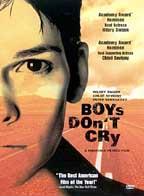FILM NOTES
FILM NOTES INDEX
NYS WRITERS INSTITUTE
HOME PAGE

Directed by Kimberly Peirce, produced by Christine Vachon
(United States, 1991, 85 minutes, b&w and color, 35mm)
Cast:
Hilary Swank. . . . . . . . . . Brandon Teena
Chloe Sevigny . . . . . . . . . .Lana Tisdel
Peter Sarsgaard . . . . . . . . . .John Lotter
Brendan Sexton III . . . . . . . . . . Tom Nissen
The
following film notes were prepared for the New York State Writers
Institute by Kevin Jack Hagopian, Senior Lecturer in Media Studies
at Pennsylvania State University:
Kimberly Peirce's Boys Don't Cry is one of the eeriest, most deeply tragic films of recent years. Based on the killing of transsexual Brandon Teena/Teena Renae Brandon in 1992, the film is a double portrait of sympathy and misanthropy; Brandon and her lover find a fragile peace with the truth of who they both are - and two young men who are torn apart by their own equally fragile maleness. Shattered at the thought of a female transsexual who had "passed" successfully as a male friend in their midst, they set out to destroy her. Finding love in such hopelessness, the troubled and troubling Brandon (played in one of the most fully-committed screen performances of the last several years by Hilary Swank) finds an emotional haven with Lana Tisdel (Chloe Sevigny).
Like Richard Fleischer's In Cold Blood and Terence Malick's Badlands, this riff on a `real life story' takes place on the tundra of the American great plains, an emotional wasteland as barren as its landscape. This flat hell has also given shape to films as varied in their representation of the West's capacity for intense alienation as My Own Private Idaho and The Laramie Project -- Boys Don't Cry's finely etched picture of desolate Falls City, Nebraska is the very image of resignation and the death of ambition. In Jim Denault's searing cinematography, this is the spectral, frozen emotional landscape of Bruce Springsteen's Nebraska made real, a land of brutal affectlessness. When John Lotter and Tom Nissen (played by Peter Sarsgaard and Brendon Sexton III) discover that Brandon Teena is really Teena Brandon, they simply cannot imagine him as anything but a living insult to their overswollen masculinity. They set out to humiliate Brandon. Their hate soon overflows its shallow vessels.
The film was inspired not only by the story of the real Brandon Teena, but by the remarkable 1998 documentary film, The Brandon Teena Story, directed by Susan Muska and Greta Olofsdottir. What might have been, even ten years ago, merely a sordid and exotic `true crime' story , has been transformed by Kimberly Peirce into a gendered morality tale. Peirce's film is an essay on the arbitrariness of sexual identity, and a call for a brave and knowing humanity in the face of even the bitterest of hatreds.
The film brought renewed attention to the worn-down town that had known, too briefly, Brandon Teena, and made certain that its only fame in the decades to come would be as a setting for a moment of vengeance that called into question a national paranoia about marginal sexuality - a story that may well turn out to be essential in helping that confused nation to open its head and heart to another view of the human sexual condition. That is apparently of little solace to local citizens. The manager of the movie theater in Falls City, Jared Kirkendal, shook his head when asked about Boys Don't Cry. "That's not Falls City," he said to a reporter. "It's weird they made it more of a love story than a crime."
— Kevin Hagopian, Penn State University
For additional information, contact the Writers Institute at 518-442-5620 or online at https://www.albany.edu/writers-inst.
 Boys Don't Cry
Boys Don't Cry